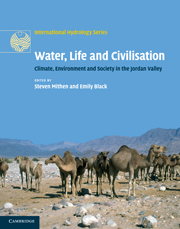Book contents
- Frontmatter
- Contents
- List of figures
- List of tables
- List of contributors
- Acknowledgements
- 1 Introduction: an interdisciplinary approach to Water, Life and Civilisation
- Part I Past, present and future climate
- Part II The palaeoenvironmental record
- Part III Hydrological studies of the Jordan Valley
- Part IV Human settlement, climate change, hydrology and water management
- 14 The archaeology of water management in the Jordan Valley from the Epipalaeolithic to the Nabataean, 21,000 BP (19,000 BC) to AD 106
- 15 From global climate change to local impact in Wadi Faynan, southern Jordan: ten millennia of human settlement in its hydrological context
- 16 Palaeoenvironmental reconstruction at Beidha, southern Jordan (c. 18,000–8,500 BP): Implications for human occupation during the Natufian and Pre-Pottery Neolithic
- 17 The influence of water on Chalcolithic and Early Bronze Age settlement patterns in the southern Levant
- 18 Modelling water resources and climate change at the Bronze Age site of Jawa in northern Jordan: a new approach utilising stochastic simulation techniques
- 19 A millennium of rainfall, settlement and water management at Humayma, southern Jordan, c. 2,050–1,150 BP (100 BC to AD 800)
- Part V Palaeoeconomies and developing archaeological methodologies
- Part VI Society, economy and water today
- Part VII Conclusions
- Index
- Plate section
- References
16 - Palaeoenvironmental reconstruction at Beidha, southern Jordan (c. 18,000–8,500 BP): Implications for human occupation during the Natufian and Pre-Pottery Neolithic
from Part IV - Human settlement, climate change, hydrology and water management
Published online by Cambridge University Press: 26 April 2011
- Frontmatter
- Contents
- List of figures
- List of tables
- List of contributors
- Acknowledgements
- 1 Introduction: an interdisciplinary approach to Water, Life and Civilisation
- Part I Past, present and future climate
- Part II The palaeoenvironmental record
- Part III Hydrological studies of the Jordan Valley
- Part IV Human settlement, climate change, hydrology and water management
- 14 The archaeology of water management in the Jordan Valley from the Epipalaeolithic to the Nabataean, 21,000 BP (19,000 BC) to AD 106
- 15 From global climate change to local impact in Wadi Faynan, southern Jordan: ten millennia of human settlement in its hydrological context
- 16 Palaeoenvironmental reconstruction at Beidha, southern Jordan (c. 18,000–8,500 BP): Implications for human occupation during the Natufian and Pre-Pottery Neolithic
- 17 The influence of water on Chalcolithic and Early Bronze Age settlement patterns in the southern Levant
- 18 Modelling water resources and climate change at the Bronze Age site of Jawa in northern Jordan: a new approach utilising stochastic simulation techniques
- 19 A millennium of rainfall, settlement and water management at Humayma, southern Jordan, c. 2,050–1,150 BP (100 BC to AD 800)
- Part V Palaeoeconomies and developing archaeological methodologies
- Part VI Society, economy and water today
- Part VII Conclusions
- Index
- Plate section
- References
Summary
ABSTRACT
The Beidha archaeological site in Southern Jordan was occupied during the Natufian (two discrete occupation phases, c. 15,200–14,200 cal. BP and c. 13,600–13,200 cal. years BP) and Pre-Pottery B Neolithic periods (c. 10,300–8,600 cal. years BP). This chapter reconstructs the palaeoenvironments at Beidha during these periods, using sedimentological observations and the stable isotopic composition (oxygen and carbon) of carbonate deposits. Age control is provided by uranium-series and radiocarbon dating. Detailed analysis of a carbonate stratigraphic section related to a fossil spring close to the site, and a sequence of carbonate nodules from a section on the western edge of the archaeological site, permits a reconstruction of climatic variations between c. 18,000 and c. 8,500 years BP. The results of the palaeoenvironmental study are compared with the archaeological evidence, to explore the relationship between human occupation and climatic variability at Beidha. The results indicate a marked correspondence between more favourable (wetter) environmental conditions and phases of occupation at Beidha, and provide clues to the likely sources of water that sustained the settlement during the Late Pleistocene and early Holocene.
INTRODUCTION
Climate change during the Late Pleistocene–early Holocene is often seen as a key factor in the transition to sedentism and stable, agricultural societies in the Middle East, given the background of major events such as the start of the Younger Dryas and the Holocene (e.g. Moore and Hillman, 1992; Mithen, 2003; Cordova, 2007, see also Feynman and Ruzmaikin, 2007).
- Type
- Chapter
- Information
- Water, Life and CivilisationClimate, Environment and Society in the Jordan Valley, pp. 245 - 268Publisher: Cambridge University PressPrint publication year: 2011
References
- 5
- Cited by

